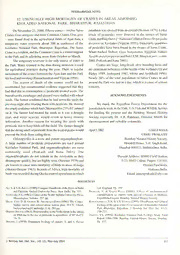
Unusually High Mortality of Cranes in Areas Adjoining Keoladeo National Park, Bharatpur, Rajasthan PDF
Preview Unusually High Mortality of Cranes in Areas Adjoining Keoladeo National Park, Bharatpur, Rajasthan
MISCELLANEOUS NOTES UNUSUALLY HIGH MORTALITY OF CRANES IN AREAS ADJOINING 12. KEOLADEO NATIONAL PARK, BHARATPUR, RAJASTHAN On November23, 2000, fifteen cranes- twelve Sams parathionwassprayedfromanaircraft(Newton 1979). Lethal Cranes Grus antigone and three Common Cranes Grusgms levels of pesticides were detected in the tissues of Sarus - were found dead in the agricultural fields ofAjan dam, a CraneandRingDove(=EurasianCollared-Dove)Streptopelia temporary water reservoir about 500 m southwest of the decciocto in Keoladeo (Vijayan 1991). Detectable quantities Keoladeo National Park, Bharatpur, Rajasthan. The Sarus ofpesticides have been found in the tissues ofSarus Crane, Crane isaresident,andtheCommonCraneisawintermigrant White-backed Vulture Gyps bengalensis, Egyptian Vulture tothe Parkand its adjoining areas from Octoberto March. Neophronpercnopterusandfish(A.M. Bhagwatpers. comm. The temporary reservoir is the only source ofwaterto 2001, PrakashandRana2001). the Park. Waterretained in the dam during monsoon is used Cranes are large, long-lived, slow breeding birds and for agricultural practices during the year. There is regular areprominent indicatorsofthe health ofthewetland(Ali and movement ofthe cranes between the Ajan dam and the Park Ripley 1989, Jonhsgard 1983, Meine and Archibald 1996). forfoodandroosting(RamachandranandVijayan 1994). Nearly 20% ofthe total population ofSarus Cranes in and The reason of death of the cranes could not be around the Park was lost in a day, which is acause ofserious ascertained, but circumstantial evidence suggested that they concern. had died due to consumption ofpesticide-treated seeds. The ACKNOWLEDGEMENTS buccal cavity,esophagusandgizzardwerestuffedwithwheat seeds. The farmer confirmed that he had sown the seeds the previousnight aftertreatingthem with pesticide. He showed We thank the Rajasthan Forest Department for the theemptycontainerwhichhadChloropyrifos25%ECprinted permissiontoworkinthePark, U.S. Fishand Wildlife Service on it. The farmer had treated the seeds as it was a drought for funding the project and the Bombay Natural History year, and water scarcity would result in heavy termite Society, especially Dr. A.R. Rahmani, Director, BNHS for infestation. Another reason for treating the seeds with encouragement and valuable comments. pesticide was to keep birds offthe field. The farmerthought thatthestrongsmellofpesticidefromthetreatedgrainswould April2,2002 GARGI RANA prevent the birds from eatingthem. VIBHU PRAKASH1 Chloropyrifos is a toxic and potent organophosphate. BombayNatural HistorySociety, A large number of pesticide preparations are used around Hornbill House, S.B. Singh Road, Keoladeo National Park, and organophosphates are most Mumbai400023, Maharashtra, India. commonly used (Prakash and Rana 2001). The organophosphates do not remain in the ecosystem as they 'Present Address: BNHS Field Station, disintegrate quickly, but are highlytoxic (Newton 1979) and F-23,HMTColony,Pinjore 134 101, are known to cause mass mortality ofbirds in areas ofusage District Panchkula, (Morzer-Bruyne 1963). In parts ofAfrica, high mortality of Haryana,lndia. birdswasrecordedduringQueliacontroloperationsinwhich Email:[email protected] REFERENCES Ali,S.&S.D. Ripley(1989):CompactHandbookoftheBirdsofIndia Ltd. England. Pp. 399 and Pakistan. Oxford University Press. New Delhi. Pp. 737. Prakash, V. & Gargi Rana (2001): Effect of environmental Jonhsgard,PA.(1983):CranesoftheWorld. IndianaUniversityPress, contamination on raptors with special reference to Shaheen. Bloomington, Indiana. 257 pp. Unpublished report. BombayNatural History Society. Meine. Curt D. & George W. Archibald (Eds) (1996): The Cranes: Ramachandran,N.K.&V.S. Vijayan(1994): DistributionandGeneral Status survey and conservation action plan. IUCN, Gland, Ecologyofthesaruscrane(Grusantigone)inKeoladeoNational SwitzerlandandCambridge,U.K. 294pp. Park. Bharatpur, Rajasthan. J. Bombay Nat. Hist. Soc. 91(2): Morzer-Bruyne(1963): BirdmortalityintheNetherlandsinthespring 210-223. of I960duetotheuseofpesticide in agriculture. 1CBPBull 9: Vijayan, V.S. (1991): Keoladeo National Park Ecology Study. Final 70-75 Report 1980-1990. BombayNatural History Society, Bombay. Newton, I. (1979): Population Ecology ofraptors. T. and A. Poyser Pp. 337. J. Bombay Nat. Hist. Soc., 101 (2), May-Aug 2004 317
